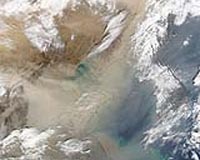| . |  |
. |
Albuquerque NM (SPX) Nov 10, 2009 The Environmental Restoration Project at Sandia National Laboratories reports the successful construction of an alternative evapotranspirative cover at the Mixed Waste Landfill (MWL) in September. The 2.6-acre site is located in Technical Area 3 in the west-central part of Kirtland Air Force Base. The protective cover consists of four engineered layers, including three layers of compacted soil and a biointrusion rock barrier that will keep burrowing animals out of the former disposal areas. Together, these four layers and the native plants will control water infiltration, thus isolating the wastes from the accessible environment. Because the cover is constructed without rigid layers, it can accommodate differential subsidence without undue impairment of its performance. The MWL was established in 1959 as a disposal area for low-level radioactive waste generated by Sandia's research facilities. Low-level radioactive waste and minor amounts of hazardous waste were disposed in the MWL from 1959 through 1988. Approximately 100,000 cubic feet of waste containing about 6,300 curies of activity (in 1989) were disposed of in the landfill. Over time, the radioactive materials in the landfill decay and become less hazardous. The MWL has been monitored since 1969 and actively studied since 1991. An extensive investigation effort provided the technical foundation for the determination that the landfill is not expected to contaminate groundwater and does not represent an unacceptable risk to human health and the environment. After the extensive investigation, public meetings and a public hearing, the New Mexico Environment Department (NMED) Secretary issued the final order in 2005 selecting an evapotranspirative cover with a biointrusion rock barrier as the selected remedy. After a review of competitive bids, Sandia awarded the construction contract to a local, small business. Cover construction was completed on schedule, near budget and without any safety incidents. The NMED regulates the corrective action of the MWL as well as the implementation of institutional controls and long-term monitoring and maintenance. Sandia and DOE continue to provide quarterly progress reports to the NMED. In addition, the final order requires compilation of a report that re-evaluates the feasibility of excavation and analyzes the continued effectiveness of the selected remedy every five years. Construction of the MWL alternative cover will be documented in the Corrective Measures Implementation Report which will be submitted to the NMED for approval. According to NNSA Sandia Site Office Federal Project Director Joe Estrada, "If it had not been for the personal perseverance of the project team, this mission would have withered. Now that the remedy is in place the team is looking forward to sharing lessons learned from the project." The implementation of the selected remedy at the MWL is a critical step forward for the site. More than a decade of work and many personnel contributed to the success of the project. Although the cover is now constructed, monitoring work continues at the MWL. "The groundwater, soil gas and the cover will be monitored long-term to ensure performance and the protection of human health and the environment," said ER project task leader Mike Mitchell. Sandia National Laboratories is a multiprogram laboratory operated by Sandia Corporation, an autonomous Lockheed Martin company, for the U.S. Department of Energy's National Nuclear Security Administration. With main facilities in Albuquerque, N.M., and Livermore, Calif., Sandia has major R and D responsibilities in national security, energy and environmental technologies, and economic competitiveness. Share This Article With Planet Earth
Related Links Sandia National Laboratories Our Polluted World and Cleaning It Up
 SKorea to plant trees in China to reduce 'yellow dust'
SKorea to plant trees in China to reduce 'yellow dust'Seoul (AFP) Nov 4, 2009 The Seoul city government will help fund a tree-planting project in a Chinese desert to reduce the amount of harmful "yellow dust" blowing over South Korea, officials said Wednesday. The city government signed an accord Tuesday to invest 50 million won (42,000 dollars) in the planting project led by Future Forest, a South Korean environmental group operating in China for the past 10 years. ... read more |
|
| The content herein, unless otherwise known to be public domain, are Copyright 1995-2009 - SpaceDaily. AFP and UPI Wire Stories are copyright Agence France-Presse and United Press International. ESA Portal Reports are copyright European Space Agency. All NASA sourced material is public domain. Additional copyrights may apply in whole or part to other bona fide parties. Advertising does not imply endorsement,agreement or approval of any opinions, statements or information provided by SpaceDaily on any Web page published or hosted by SpaceDaily. Privacy Statement |